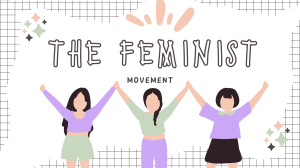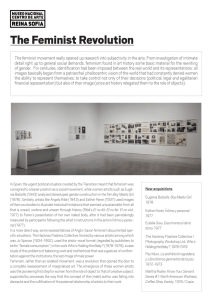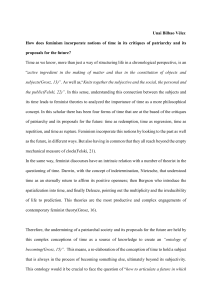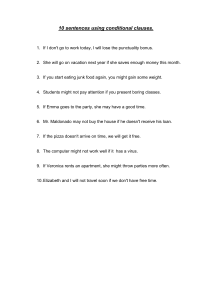Copia de Miguel Ángel Fernández Reyes - Women in 19th and 20th century
Anuncio
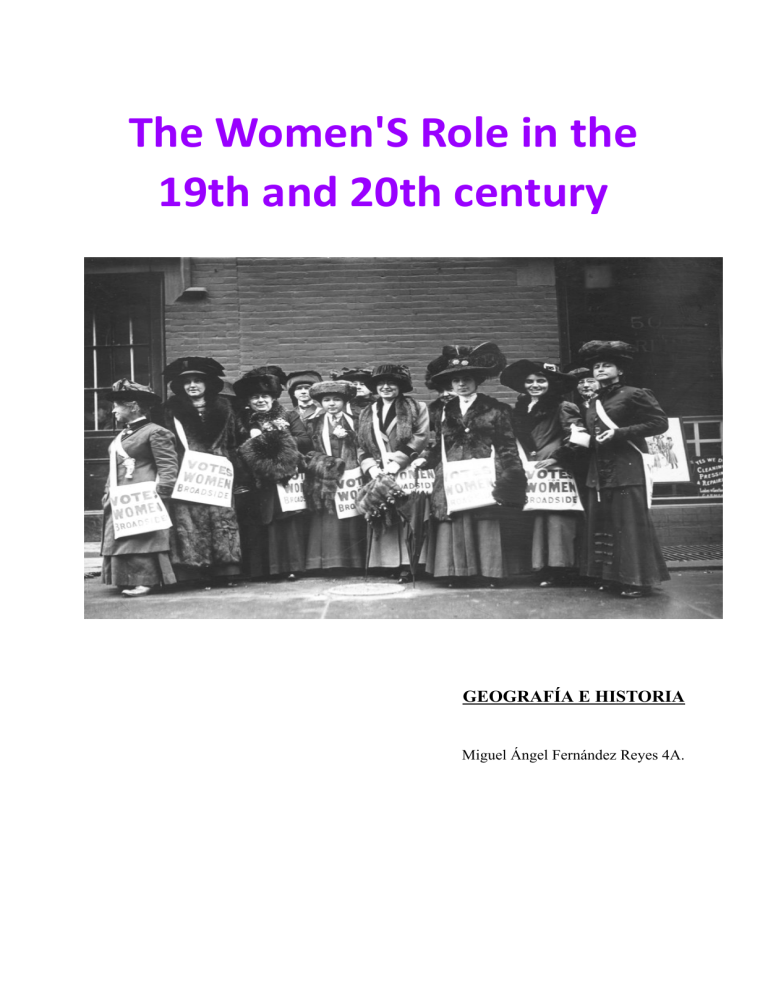
The Women'S Role in the 19th and 20th century GEOGRAFÍA E HISTORIA Miguel Ángel Fernández Reyes 4A. Activities 1) You’ve just watched the movie ‘Suffragette’ (United Kingdom, 2015). Answer True or False to the following question TRUE a. Working class women were expected to marry young, care for their home and children, and help support the family. X b. Women did not have universal access to free and public education. X c. Women could not file for divorce without their husband’s consent. X d. In wartime, women were prohibited from working in munitions factories. FALSE X e. Women were forbidden to organize to promote their cause. X f. Authorities could force-feed women prisoners who engaged in hunger strikes to promote their cause. X g. Men who assaulted women protesters were rarely, if ever, punished. X h. The law transferred a woman’s wealth and property to her husband when she married. X i. Women received pay equal to men for their work. X j. Women were allowed custody of their children if they divorced their husband. X 2) What is the Women’s Suffrage Movement? Explain with your own words. The suffrage movement, which emerged in the second half or the 19th century. Suffrage movement was one of the great struggles of feminism. In the passage from the nineteenth to the twentieth century, Britain witnessed the hard struggle of the leaders of the suffragette movement for recognition of the right of women to vote. Violence, prison, hunger strikes, large demonstrations... Until finally, they got it in February 1918. 3) What difficulties did women face in their fight for rights? In the 19th century, a movement opposing the suffragettes emerged. The anti-suffragettes included men and women who believed it was unnatural for women to have the same rights as men. Anti-suffragettes believed the only purpose of women was to be a wife and a mother, caring for their families. 4) Make a chronological line with the countries that approved the right to vote of women, including Spain. What other rights did they get? Women also got the rights of a mother over her children, they got the same right to vote, as men. 5) Write the names of 5 women who fought for the right to vote for women. Clara Campoamor Victoria Kent Margarita Nelken Emmeline Pankhurst Emma Watson 6) What is the vision of women in the early twentieth century? Compare the situation in the USA and Spain (during the Second Republic and Francoism). Women in the early twentieth century joined the workforce in large numbers during World war I. This changed the way women dressed. To work in confort, women no longer wore long, stiff dresses;they wore shorter, looser dresses and also began to wear trousers. Previously, many women never cut their hair but now they wore it short because long hair could get caught in factory machines. Women could do sports previously reserved for men, such as tennis, swimming and cycling. During the Second Republic women were poorly educated, and most of them were illiterate in addition, they were under the authority of then, who were either their fathers or husbands and they had no political rights.Many women worked in farms or in factories, but always on very low salaries.their jobs not free them from housework, because it was considered their main duty. The suffrage movement was less developed in Spain than in some other countries. Women could not vote when the Second Republic was proclaimed, but women over 23 years or age could be elected to certain public offices. Thus, there were three female members of parliament in the constituent parliament of 1931: Clara Campoamor, Margarita Nelken and Victoria Kent, during Francoism a patriarchal family was imposed during Franco's dictatorship. A woman's role was to be wife and mother.Women lost many of the rights they had won during the Second Republic. They were only allowed to work if they had permission from their father or husband, and they were banned from certain professions, such as diplomat, judge or other legal positions. Women had to dress modestly. From the 1960s, women had better access to education and paid work, which improved their situation.However, discrimination against women still persisted. 7) Explain the concept of Feminism. It is the same to say Feminazi? What is the difference? While feminism fights to end the privileges of men to achieve equality between both sexes, the term feminazi implies that women consider themselves superior to men and aspire to their domination 8) Read the speech that Emma Watson gave at the United Nations Conference about Feminism. What do you think? Write an essay of 180-200 words giving your opinion about the role of women today and the new fights of the feminist movement nowadays. Emma Watson is a feminist who does not get carried away by radicalism, she talks about equality, that no sex has more opportunities because of its gender condition. Feminism does not want to impose a matriarchy based on violence against men, as patriarchy has been until now. He does not want to leave them without a vote, or rape them in wars, or mutilate their genitals for the sake of a cultural tradition, or confine them in the domestic sphere, nor does he want to kill them for adultery.Feminism does not want men to be owned by their mothers and then by their women, not does it want men to receive lower wages, nor would it want to banish them from the domes of media, business and political power. It does not want to traffic in male bodies for the enjoyment of female bodies, nor does it want male children to be malnourished or abandoned in orphanages, nor, of course, would it promote their social or economic marginalization. Nor would I veto boys from.They could go to school, nor would they be forbidden access to health care and the University. I understand that this is crazy that feminism does not promote.
